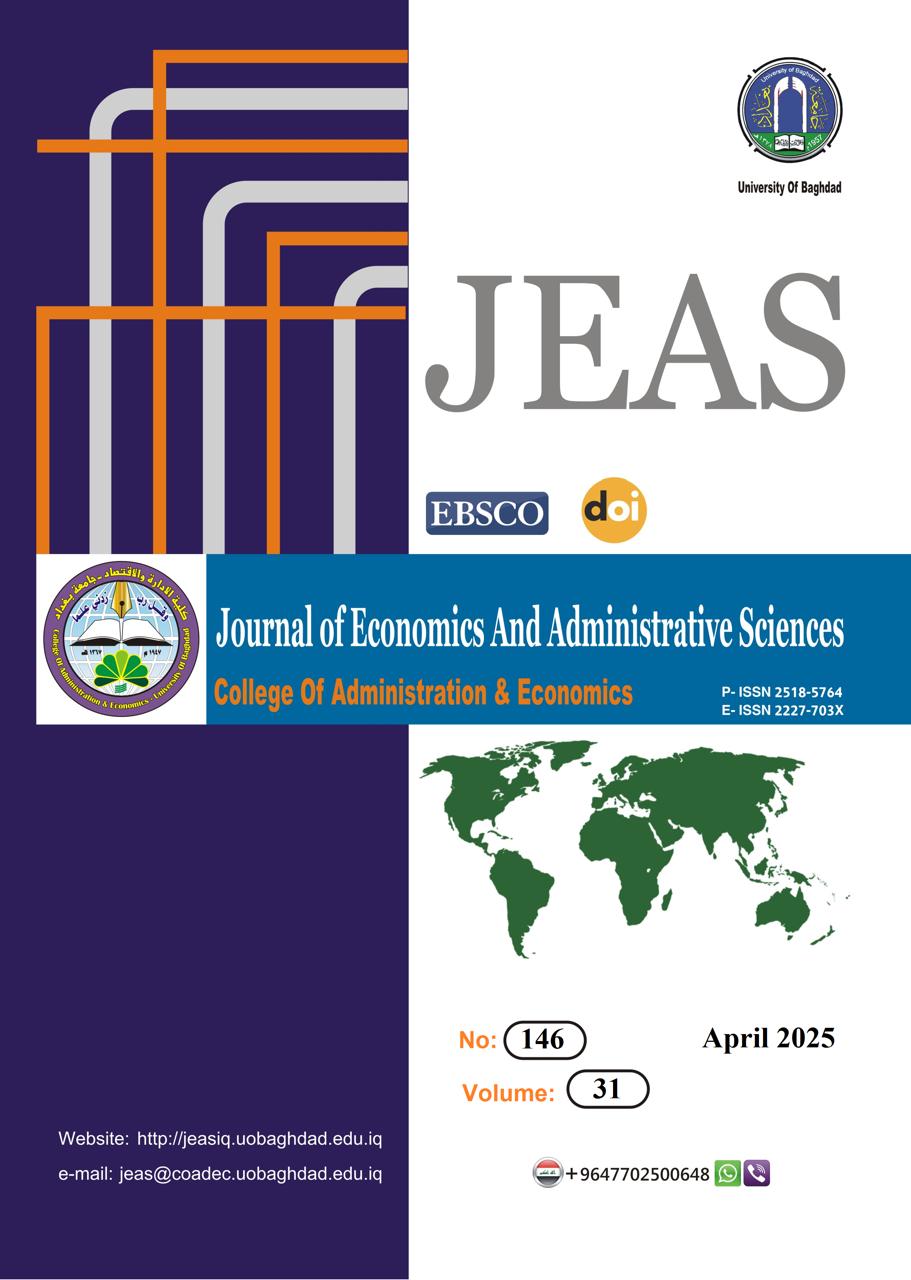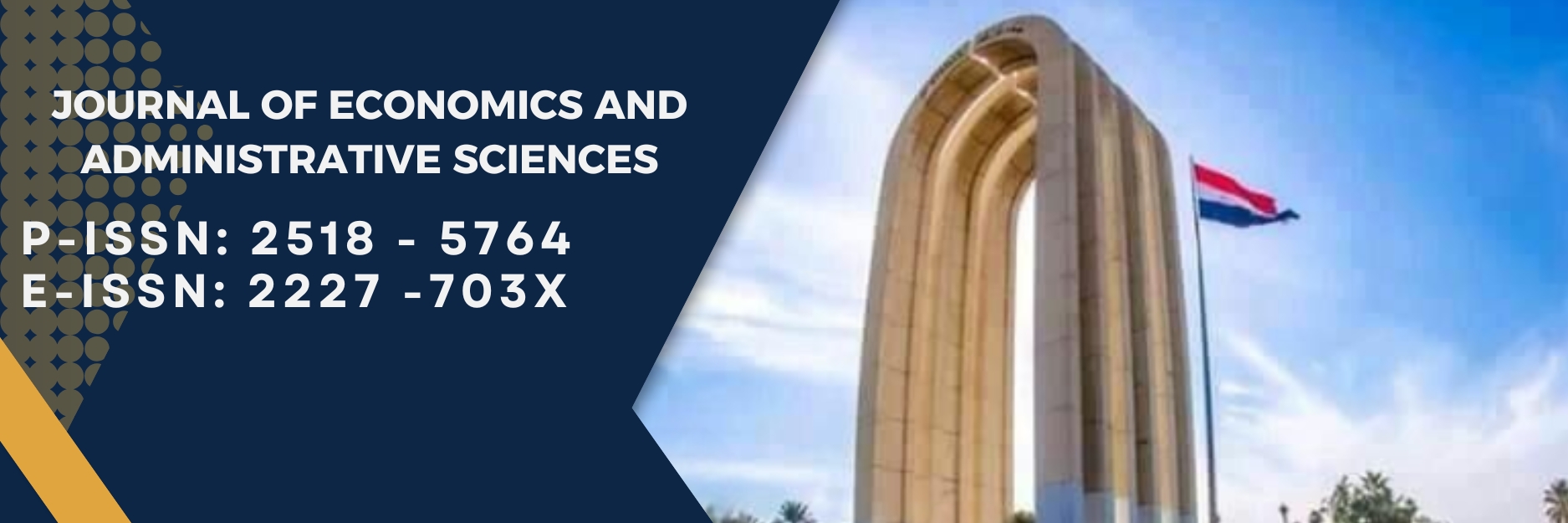Spatial Quantile Autoregressive Model: A Review
DOI:
https://doi.org/10.33095/45aqgm03Abstract
This paper is specifically a detailed review of the Spatial Quantile Autoregressive (SARQR) model that refers to the incorporation of quantile regression models into spatial autoregressive models to facilitate an improved analysis of the characteristics of spatially dependent data. The relevance of SARQR is emphasized in most applications, including but not limited to the fields that might need the study of spatial variation and dependencies. In particular, it looks at literature dated from 1971 and 2024 and shows the extent to which SARQR had already been applied previously in other disciplines such as economics, real estate, environmental science, and epidemiology.
Accordingly, evidence indicates SARQR has numerous benefits compared to traditional regression models: These estimates are robust to outliers and heterogeneous spatial effects and capture fully conditional distributions with respect to mean regression models. The review supports future work toward enhancing estimation approaches and possible SARQR application extensions to other fields. The spatial modeling has applicability in the research, decision-making, and profession formulation because it encourages a broader SARQR application in economic analysis, infrastructure planning, and public health policy. Future research must aim at refining estimation methods and integrating SARQR with other models of analysis to optimize its usefulness in utilizing sophisticated spatial data.
Downloads
References
Al-Tai, A. A., & Al-Kazaz, Q. N. N. (2022). Semi parametric Estimators for Quantile Model via LASSO and SCAD with Missing Data. Journal of Economics and Administrative Sciences, 28(133), 82–96. https://doi.org/10.33095/jeas.v28i133.2351
Ali, O. A., & Hadi, S. Q. (2014). Spatial Regression Models Estimation for the poverty Rates In the districts of Iraq in 2012. Journal of Economics and Administrative Sciences, 20(79), 337–351. https://doi.org/10.33095/jeas.v20i79.1962
Baha Alwan, E., & Abdulmohsin Ali, O. (2024). About Semi-parametric Methodology for Fuzzy Quantile Regression Model Estimation: A Review. Journal of Economics and Administrative Sciences, 29(138), 127–146. https://doi.org/10.33095/jeas.v29i138.3044
Benoit, D. F., Alhamzawi, R., & Yu, K. (2013). Bayesian lasso binary quantile regression. Computational Statistics, 28, 2861–2873.
Benoit, D. F., & van den Poel, D. (2017). BayesQR: A bayesian approach to quantile regression. Journal of Statistical Software, 76(1). https://doi.org/10.18637/jss.v076.i07
Castillo-Mateo, J., Asín, J., Cebrián, A. C., Gelfand, A. E., & Abaurrea, J. (2023). Spatial Quantile Autoregression for Season Within Year Daily Maximum Temperature Data. Annals of Applied Statistics, 17(3), 2305–2325. https://doi.org/10.1214/22-AOAS1719
Chen, J., & Rodden, J. (2009). Tobler’s law, urbanization, and electoral bias: why compact, contiguous districts are bad for the Democrats. Unpublished Mimeograph, Department of Political Science, Stanford University.
Chen, J., Song, J. J., & Stamey, J. D. (2022). A Bayesian hierarchical spatial model to correct for misreporting in count data: application to state-level COVID-19 data in the United States. International Journal of Environmental Research and Public Health, 19(6), 3327.
Dai, X., Li, S., Jin, L., & Tian, M. (2022). Quantile regression for partially linear varying coefficient spatial autoregressive models. Communications in Statistics-Simulation and Computation, 1–16.
Febriyanti, A., Djuraidah, A., & Wigena, A. H. (2015). Spatial Autoregressive Quantile Regression Modelling for Gross Domestic Regional Product Data (Case: 113 Districts/Cities in Java in 2010). Global Journal of Pure and Applied Mathematics, 11(4), 2255–2264.
Fisher, W. D. (1971). Econometric estimation with spatial dependence. Regional and Urban Economics, 1(1), 19–40.
Gaosheng, L., & Yang, B. (2023).
FunctionalQuantileSpatialAutoregressiveModelandItsApplication. J. Sys. Sci. & Math. Scis., 43(12), 3361–3376.
Gumprecht, D. (2005). Spatial Methods in Econometrics : An Application to R & D Spillovers. December, 1–17. https://doi.org/10.57938/39f720e6-61c9-40fd-a88b-ec1a3a83fe12
Hallin, M., Lu, Z., & Yu, K. (2009). Local linear spatial quantile regression. Bernoulli, 15(3), 659–686. https://doi.org/10.3150/08-BEJ168
Hapsery, A., Mustikawati, E., Hermanto, P., & Aprilia, Y. U. (2024). Perbandingan SAR dan SARQR Pada Pemodelan Indeks Pembangungan Manusia di Jawa Tengah Tahun 2022. 12, 581–592. https://doi.org/10.14710/J.GAUSS.12.4.581-592
Helbich, M., Brunauer, W., Vaz, E., & Nijkamp, P. (2014). Spatial Heterogeneity in Hedonic House Price Models: The Case of Austria. Urban Studies, 51(2), 390–411. https://doi.org/10.1177/0042098013492234
Hussein, S. M., & Akkar, A. A. (2019a). Proposing core functions with a two-stage method to estimate the SPSEM model. Journal of Administration & Economics, 42(122), 529–544.
Hussein, S. M., & Akkar, A. A. (2019b). Some Estimation methods for the two models SPSEM and SPSAR for spatially dependent data”, Journal of Economics and Administrative Sciences, 25(113), pp. 499–525. doi:10.33095/jeas.v25i113.1710.
Hussein, S. M., & Akkar, A. A. (2023). Using some proposed kernel functions in estimating the semi-parametric spatial error regression model (spsar) using the locally linear estimator. Journal of Statistical Sciences, 20, 11–27.
Koenker, R., & Bassett Jr, G. (1978). Regression quantiles. Econometrica: Journal of the Econometric Society, 33–50.
Kostov, P. (2009). A spatial quantile regression hedonic model of agricultural land prices. Spatial Economic Analysis, 4(1), 53–72.
Lee, J., & Huang, Y. (2024). Social Vulnerability and COVID-19 Pandemic Outcomes: Evidence from Spatial Quantile Regression. Review of Regional Studies, 54(1), 27–52. https://doi.org/10.52324/001c.117217
Lee, J., Kim, J., Shin, J., Cho, S., Kim, S., & Lee, K. (2023). Analysis of wildfires and their extremes via spatial quantile autoregressive model. Extremes, 26(2), 353–379. https://doi.org/10.1007/s10687-023-00462-0
LeSage, J. P. (1999). The theory and practice of spatial econometrics. University of Toledo. Toledo, Ohio, 28(11), 1–39.
LeSage, J. P., & Parent, O. (2007). Bayesian model averaging for spatial econometric models. Geographical Analysis, 39(3), 241–267. https://doi.org/10.1111/j.1538-4632.2007.00703.x
Li, Q., & Liny, N. (2010). The Bayesian elastic net. Bayesian Analysis, 5(1), 151–170. https://doi.org/10.1214/10-BA506
Liao, W. C., & Wang, X. (2012). Hedonic house prices and spatial quantile regression. Journal of Housing Economics, 21(1), 16–27. https://doi.org/10.1016/j.jhe.2011.11.001
Liu, S., & Hite, D. (2013). Measuring the effect of green space on property value: an application of the hedonic spatial quantile regression.
Liu, X., & Chen, J. B. (2023). Variable Selection of the Spatial Autoregressive Quantile Model with Fixed Effects. Acta Mathematica Sinica, Chinese Series, 66(3), 405–424. https://doi.org/10.12386/A20210077
Lum, K., & Gelfandy, A. E. (2012). Spatial quantile multiple regression using the asymmetric Laplace process. Bayesian Analysis, 7(2), 235–258. https://doi.org/10.1214/12-BA708
Majid, H. H., & Al-Bayati, M. M. (2018a). Bayesian Tobit Quantile Regression Model Using Four Level Prior Distributions”, Journal of Economics and Administrative Sciences, 24(105), p. 487. doi:10.33095/jeas.v24i105.59.
Majid, H. H., & Al-Bayati, M. M. H. (2018b). Bayesian Tobit Quantile Regression Model Using Double Adaptive elastic net and Adaptive Ridge Regression”, Journal of Economics and Administrative Sciences, 24(107), p. 521. doi:10.33095/jeas.v24i107.1310.
Marasinghe, D. (2014). Quantile regression for climate data.
Mardia, K. V, & Marshall, R. J. (1984). Maximum likelihood estimation of models for residual covariance in spatial regression. Biometrika, 71(1), 135–146.
https://doi.org/10.24996/ijs.2022.63.9.38
Mashee Al Ramahi, F. K., & Al Bahadly, Z. K. I. (2020). The Spatial Analysis for Bassia eriophora (Schrad.) Asch. Plant distributed in all Iraq by using RS & GIS techniques. Baghdad Science Journal, 17(1), 126–135. https://doi.org/10.21123/bsj.2020.17.1.0126
Jaufar Mousa Mohammed, MaySoon M. Aziz, & Ammer Fadel Tawfeeq. (2021). Compare Between Ordinary Least Square And Maximum Likelihood Methods For Estimate Parameter Of Fuzzy Spatial Lag Model. World Bulletin of Management and Law, 6, 79-86.
Ngwira, A. (2019). Spatial quantile regression with application to high and low child birth weight in Malawi. BMC Public Health, 19(1), 1–11. https://doi.org/10.1186/s12889-019-7949-9
Paelinck, J. H. P., Klaassen, L. H., Ancot, J.-P., Verster, A. C. P., & Wagenaar, S. (1979). Spatial econometrics. (No Title).
Permai, S. D., Mukhaiyar, U., Satyaning Pp, N. L. P., Soleh, M., & Aini, Q. (2018). Spatial weighting approach in numerical method for disaggregation of MDGs indicators. IOP Conference Series: Materials Science and Engineering, 332(1).
https://doi.org/10.1088/1757-899X/332/1/012049
Rahim, S. A. (2020). A study on atmospheric pressure in krg using spatial regression (SAR and SEM). Qalaai Zanist Scientific Journal, 5(4), 917–950.
https://doi.org/10.25212/lfu.qzj.5.4.33
Rizki, M. I., & Ammar, T. (2022). Pemodelan Spatial Autoregressive Quantile Regression Pada Faktor Yang Memengaruhi Tingkat Incident Rate Demam Berdarah Dengue di Jawa Barat. Prosiding Seminar Nasional Matematika Dan Statistika, 2.
Rusche, K. (2010). Quality of life in the regions: An exploratory spatial data analysis for West German labor markets. Jahrbuch Fur Regionalwissenschaft, 30(1), 1–22. https://doi.org/10.1007/s10037-009-0042-6
Semerikova, E. V., & Blokhina, A. O. (2022). Spatial Quantile Analysis Of Real Estate Prices In Germany. Применение Многомерного Статистического Анализа в Экономике, 171.
Shawq, A. H., Globe, I. H., & Hussaini, M. (2023). Comparison of Some Spatial Regression Models Using Simulation. Journal of Techniques, 5(2).
Siregar, M. A. P. (2024). Spatial Autoregressive Quantile Regression Modeling of the Distribution of Drug Users in the District Karo. Jurnal Pijar Mipa, 19(2), 248–253.
Su, L., & Yang, Z. (2011). Instrumental Variable Quantile Estimation of Spatial Autoregressive Models. 1-35.
Tribhuwaneswari, A. B., Hapsery, A., & Rahayu, W. K. (2022). Spatial autoregressive quantile regression as a tool for modelling human development index factors in 2020 East Java. AIP Conference Proceedings, 2668(October). https://doi.org/10.1063/5.0112828
Trzpiot, G. (2012). Spatial quantile regression. Comparative Economic Research. Central and Eastern Europe, 15(4), 265–279.
Tuofu, H., Qingyun, H., Dongxiao, Y., & Xiao, O. (2021). Evaluating the Impact of Urban Blue Space Accessibility on Housing Price: A Spatial Quantile Regression Approach Applied in Changsha, China. Frontiers in Environmental Science, 9(May), 1–15. https://doi.org/10.3389/fenvs.2021.696626
Wardhani, A. P., & Yanti, T. S. (2021). Pemodelan Spatial Autoregressive Quantile Regression (SARQR) pada Data Gizi Buruk Balita di Kota Bandung. Proding Statistika, 606–612. http://dx.doi.org/10.29313/.v0i0.29229
Yang, Y., & He, X. (2015). Quantile regression for spatially correlated data: An empirical likelihood approach. Statistica Sinica, 25(1), 261–274.
https://doi.org/10.5705/ss.2013.065w
Yu, K., & Lu, Z. (2003). Quantile regression : applications and current research areas. 331–350.
Yu, K., & Moyeed, R. A. (2001). Bayesian quantile regression. 54(January), 437–447.
Yu, T., Gao, F., Liu, X., & Tang, J. (2021). A spatial autoregressive quantile regression to examine quantile effects of regional factors on crash rates. Sensors, 22(1), 5.
Zhang, H., & Wang, X. (2016). Effectiveness of Macro-regulation Policies on Housing Prices: A Spatial Quantile Regression Approach. Housing, Theory and Society, 33(1), 23–40. https://doi.org/10.1080/14036096.2015.1092467
Zhang, L. (2016). Flood hazards impact on neighborhood house prices: A spatial quantile regression analysis. Regional Science and Urban Economics, 60, 12–19. https://doi.org/10.1016/j.regsciurbeco.2016.06.005
Zietz, J., Zietz, E. N., & Sirmans, G. S. (2008). Determinants of house prices: A quantile regression approach. Journal of Real Estate Finance and Economics, 37(4), 317–333. https://doi.org/10.1007/s11146-007-9053-7
Published
Issue
Section
License
Copyright (c) 2025 Journal of Economics and Administrative Sciences

This work is licensed under a Creative Commons Attribution-NonCommercial-NoDerivatives 4.0 International License.
Articles submitted to the journal should not have been published before in their current or substantially similar form or be under consideration for publication with another journal. Please see JEAS originality guidelines for details. Use this in conjunction with the points below about references, before submission i.e. always attribute clearly using either indented text or quote marks as well as making use of the preferred Harvard style of formatting. Authors submitting articles for publication warrant that the work is not an infringement of any existing copyright and will indemnify the publisher against any breach of such warranty. For ease of dissemination and to ensure proper policing of use, papers and contributions become the legal copyright of the publisher unless otherwise agreed.
The editor may make use of Turtitin software for checking the originality of submissions received.


























